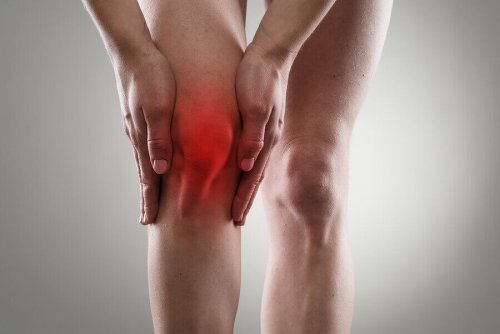What Causes a Tendon Injury?

With the beginning of a new year and new year resolutions, many people choose to take up exercising. But, sometimes people try to do too much too fast. If you push your body to its limits, you might be setting yourself up for injury. One common example of an over-exertion injury is the tendon injury.
Tendons are structures that respond poorly to over-exertion after a sedentary period. In this article, we’ll be discussing the types of activities that can cause a tendon injury.
So, what are tendons?
The tendons are dense tissue structures located at the ends of your muscles. Their function is to attach the muscles to the bones. That’s why they form their insertions.
They’re also in charge of transmitting force to the bones, that the muscles generate. This is the means through which the body produces movement. As you can imagine, this makes them key players in the locomotor apparatus.

As this is connective tissue, they’re made of collagen. Specifically, they’re made up of type 1 collagen fiber. These fibers are surrounded by an extracellular matrix that has an abundant number of fibroblasts. These are a type of connective cell tissue that regenerates tendon collagen.
It also has a high quantity of water and substances derived from carbohydrates such as proteoglycans. All of these qualities give these structures their hardness and elasticity.
How does a tendon become injured?
There are many ways for a tendon to become injured, but they’re always either related to blunt injuries or over-exertion. When we’re talking about blunt trauma, accidental falls or heavy bruising are the culprits. These can produce inflammation in the tendinous structures and eventually lead to tendinopathy.
When physical exertion causes an injury, the injury’s origin tends to be muscle overload. An overloaded or over-contracted muscle can pull away from the tendon and rub against other structures. Aside from that, the elongation of the tendon can make it more prone to injury. This happens frequently in the movements required for running, squatting, or even just cycling.
Symptoms of a tendon injury
The symptoms of a tendon injury depend on the type and place of the injury. Yet they all tend to have a few common characteristics:
- Stiffness and mild loss of mobility.
- Pain and sensitivity when you move the connected joints.
- Thickening of the joint.
- You might be able to hear or feel creaking when you move the tendon.
Treatments for tendinopathy
The treatment of a tendon injury is similar to that of a muscle injury. It requires rest as well as measures to strengthen the injured area. At least that’s the case when the tendinopathy is caused by excess physical exertion.
- Your rest should be an active type of rest. That’s to say, it’s important to combine rest from the movements that are most strongly affected with more activity through alternate movements that help strengthen the tendon.
- If you have continuous pain, you can use anti-inflammatory and analgesic balms. Alternatively, you can take such medicine orally.
- If your tendinopathy is recurrent, it’s a good idea to see a physiotherapist. They’ll be able to evaluate your case and tell you how to strengthen your tendons so they don’t limit your sporting activities.

Tendinopathy or tendinitis – what should you call a tendon injury?
We should stress a concept that elicits a lot of questions and controversy among people. This is the concept of “tendinitis,” which literally means inflammation of the tendon. The suffix “-itis,” refers to the inflammation of structure.
When you injure a tendon, inflammation occurs in the tissue surrounding that tendon. There are many inflammation mechanisms, but you can summarize them as being a migration of immune system cells to the injured area in an attempt to repair it. The cardiovascular system is the road through which this migration takes place. Specifically, they reach the damaged tissue by means of capillaries.
Tendon tissue is avascular in nature. That means that capillaries don’t irrigate it. Instead, it gets its nutrition from the extracellular matrix. Tissue that doesn’t make use of blood irrigation can never become inflamed. This makes the term “tendinitis,” as such, inappropriate.
What really becomes injured in these cases are the structures connected to the tendons. That’s why you call it “tendinopathy.” The suffix “-pathy” means an illness. So this term means a “tendon illness.”
With the beginning of a new year and new year resolutions, many people choose to take up exercising. But, sometimes people try to do too much too fast. If you push your body to its limits, you might be setting yourself up for injury. One common example of an over-exertion injury is the tendon injury.
Tendons are structures that respond poorly to over-exertion after a sedentary period. In this article, we’ll be discussing the types of activities that can cause a tendon injury.
So, what are tendons?
The tendons are dense tissue structures located at the ends of your muscles. Their function is to attach the muscles to the bones. That’s why they form their insertions.
They’re also in charge of transmitting force to the bones, that the muscles generate. This is the means through which the body produces movement. As you can imagine, this makes them key players in the locomotor apparatus.

As this is connective tissue, they’re made of collagen. Specifically, they’re made up of type 1 collagen fiber. These fibers are surrounded by an extracellular matrix that has an abundant number of fibroblasts. These are a type of connective cell tissue that regenerates tendon collagen.
It also has a high quantity of water and substances derived from carbohydrates such as proteoglycans. All of these qualities give these structures their hardness and elasticity.
How does a tendon become injured?
There are many ways for a tendon to become injured, but they’re always either related to blunt injuries or over-exertion. When we’re talking about blunt trauma, accidental falls or heavy bruising are the culprits. These can produce inflammation in the tendinous structures and eventually lead to tendinopathy.
When physical exertion causes an injury, the injury’s origin tends to be muscle overload. An overloaded or over-contracted muscle can pull away from the tendon and rub against other structures. Aside from that, the elongation of the tendon can make it more prone to injury. This happens frequently in the movements required for running, squatting, or even just cycling.
Symptoms of a tendon injury
The symptoms of a tendon injury depend on the type and place of the injury. Yet they all tend to have a few common characteristics:
- Stiffness and mild loss of mobility.
- Pain and sensitivity when you move the connected joints.
- Thickening of the joint.
- You might be able to hear or feel creaking when you move the tendon.
Treatments for tendinopathy
The treatment of a tendon injury is similar to that of a muscle injury. It requires rest as well as measures to strengthen the injured area. At least that’s the case when the tendinopathy is caused by excess physical exertion.
- Your rest should be an active type of rest. That’s to say, it’s important to combine rest from the movements that are most strongly affected with more activity through alternate movements that help strengthen the tendon.
- If you have continuous pain, you can use anti-inflammatory and analgesic balms. Alternatively, you can take such medicine orally.
- If your tendinopathy is recurrent, it’s a good idea to see a physiotherapist. They’ll be able to evaluate your case and tell you how to strengthen your tendons so they don’t limit your sporting activities.

Tendinopathy or tendinitis – what should you call a tendon injury?
We should stress a concept that elicits a lot of questions and controversy among people. This is the concept of “tendinitis,” which literally means inflammation of the tendon. The suffix “-itis,” refers to the inflammation of structure.
When you injure a tendon, inflammation occurs in the tissue surrounding that tendon. There are many inflammation mechanisms, but you can summarize them as being a migration of immune system cells to the injured area in an attempt to repair it. The cardiovascular system is the road through which this migration takes place. Specifically, they reach the damaged tissue by means of capillaries.
Tendon tissue is avascular in nature. That means that capillaries don’t irrigate it. Instead, it gets its nutrition from the extracellular matrix. Tissue that doesn’t make use of blood irrigation can never become inflamed. This makes the term “tendinitis,” as such, inappropriate.
What really becomes injured in these cases are the structures connected to the tendons. That’s why you call it “tendinopathy.” The suffix “-pathy” means an illness. So this term means a “tendon illness.”
All cited sources were thoroughly reviewed by our team to ensure their quality, reliability, currency, and validity. The bibliography of this article was considered reliable and of academic or scientific accuracy.
- Brett M. Andres, and George A. C. Murrell. 2008. Treatment of Tendinopathy: What Works, What Does Not, and What is on the Horizon. https://www.ncbi.nlm.nih.gov/pmc/articles/PMC2505250/
This text is provided for informational purposes only and does not replace consultation with a professional. If in doubt, consult your specialist.








